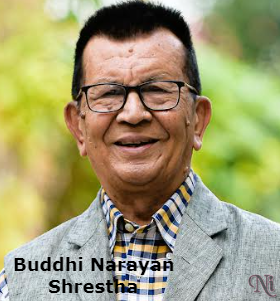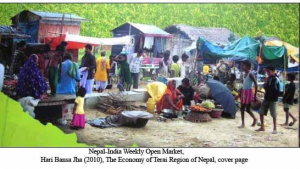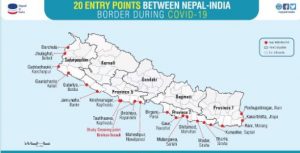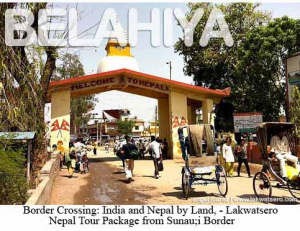Buddhi Narayan SHRESTHA
Border Expert, Kathmandu, Nepal

Key words: Open border, misused by unwanted elements, deployment of border security force, Covid-19 pandemic impact, regulate border.
Summary:
There is an open border regime between Nepal and India since centuries. But all the border-crossings have been closed dramatically during the COVID-19 pandemic period. Number of border observation posts (BoP) increased from 120 to 500 to obstruct the movement. The daily activities of borderland communities were affected. Now, the pandemic is almost over. So the open border has to be regulated deploying sufficient border observation posts (BOP) to facilitate the borderland people to cross the border in a regulated basis, also to check the corona virus carrier travelers, and to obstruct the criminals and unwanted element.
Introduction:
Nepal shares border (1880 kms) with India on the south, east, and west and with China (1439 kms) on the north. While border with India is open, mighty Himalayas constitute the frontier with China. Nepal is 23 and 68 times smaller than India and China respectively. Nepal’s population of 29 million is almost 46 times smaller than India and 49 times smaller than China. Nepal is among the landlocked and least developed countries. The nearest seaport is 1,127 and 2,700 kilometers away in India and China respectively. Kathmandu, capital city of Nepal is 3,000 km away from Beijing and 900 kms away from New Delhi. Nepal’s location is of extreme strategic and economic importance to both of them. Nepal’s land mass ranges from 57.3 metres at Musarniya in the south to 8848.86 metres elevation of Sagarmatha (Mount Everest) in the north (Bhattarai, 2022).
There is an open border regime along 1880 kilometer long Nepal-India Boundary. It has twenty major border crossing-points to cross the international border. Nepalese and Indian borderlands community inhabitants could cross the porous border from anywhere many times a day without any obstruction and interrogation before COVID-19 pandemic. During the corona virus epidemic transitional period, the border was more or less restricted. Now, the border crossing points have been vigilant, i.e. neither fully opened nor strictly regulated, after the pandemic case has gone down.
There are more than 6 million Nepali people working in India in various capacities such as security guard, domestic workers, hotel restaurant waiters, industrial guard, porters, agriculture helpers etc. In the same way, near about 4 million Indians are working in various parts of Nepal as school teachers, carpenters, masonry workers, plumbers, electricians, furniture makers etc. They could come and go to their home for their livelihood without any obstruction. If the border police would suspect to someone, he/she should produce his/her identity proof.

It was not necessary to show any identity proof by the Nepali and Indian citizens, nor to keep the records of the movement of people, while crossing the international border before Covid-19 pandemic. But the border had been closed since 24 March 2020 from both the sides, when the Covid-19 pandemic started to spread. The border was still formally restricted, even the lockdown is released officially on 21 July 2020. Nevertheless, the local frontier inhabitants could cross the border on foot. The border police do not care them. Cargo trucks with foodstuff, fruits, vegetables and merchandise were permitted to enter from either side. However, passenger vehicles had been still interrogated and they were asked to go to the border health desk. Number of armed police personnel patrolling had been increased to supervise and check-up the movement of borderland inhabitants with a fear of transmission of pandemic. Now, Covid-19 case has been decreased in a considerable number and the border between Nepal and India is more or less relaxed.
Study area:
I have taken my case study area on and around Belahiya-Sunauli (Nepal-India) crossing-point. I have been to and from Indian towns many times through this point, before Covid-19. This is one of the major crossing gates through which 1.28 million travelers crossed the border from India to Nepal and 1.37 million people entered into Indian side from Nepal during the year 2018-19, year before Covid-19 (Khanal and Thapa, 2017).
Just three days before the lock down (20-21 March 2020) 16 to 18 thousand Nepalese, who were working in India, returned back daily their home- Nepal through this crossing-point. When the lockdown was started on 24 March, nearly 335 Nepalese were stranded in Indian frontier at that day, as the border was closed. Quarantine was managed on both the frontiers. In due time, 296 quarantined Nepalese were brought from Indian side to Nepal Belahiya side. Similarly, 252 Indians from Nepali quarantine camp were sent to Sunauli Indian frontier on 27-28 April 2020, with the consultation of both the Indian and Nepali immigration officers.
There are police post, immigration and customs posts and armed police personnel patrolling along this Belahiya-Sunauli border crossing-point. Before Covid-19 pandemic, the Indian frontier inhabitants would use to come to Bhairahawa Nepali weekly open market to sell their farm products such as vegetables, fruits, milk, ghee and consumable goods in a higher price. Nepalese borderland community people would go to Indian Sunauli market to buy sugar, salt, spices, daily necessities and cotton clothes in a cheaper rate in comparison to Nepali market. But these usual activities had been obstructed due to spread of corona virus. Now, it is coming slowly to pre-COVID-19 situation.
Border filtering process:
Immigration office, customs post, police check-posts personnel have been stationed in all the 20 main border crossing points along Nepal-India border. Before Covid-19, the Nepalese and Indian national could cross the international border without interrogation. They wouldn’t have to enter into the immigration check-point. But the third country nationals had to face the immigration office.
Major Customs Offices have been established to check the third country travelers and to provide visa facility. Armed police would patrol along the border to check the illegal activities. However, unwanted elements would misuse the open border. Criminals would commit crime in one frontier and they could easily flee and hide on the other side of the frontier. According to the Provincial Police Office Janakpur, regarding the criminal activities, there were 68 criminal cases registered in 2021 AD in the province. Small arms such as pistol and sharp edge weapons were used in the crime.

Terrorists used to cross the border in a disguise manner as Nepali/Indian inhabitants, as those who had their attire, posture, food habit, language, as similar as to either Indian or Nepali. There were cases of smuggling of goods and electronic materials, trafficking of girls and women, narcotic trafficking, export of fake Indian currency Notes brought from third country to Nepal and then India. These unwanted elements would try to infiltrate from the porous border, rather than the main crossing-points. All these happenings were due to less vigilance and low number of armed police personnel along the border.
Border management system changed because of Covid-19:
During the COVID-19 pandemic period, the situation of border management system had been changed dramatically. The open and porous border was changed into completely closed border system both the sides due to corona virus pandemic.
Formerly, Nepal had deployed 5,000 Armed Police Force (APF) along the border, establishing 120 BoPs, 6 to 10 kilometer apart in the plain area and 8 to 15 km apart in hilly region. It had deputed 40 APF personnel in each BoP on average. Whereas, India had deployed 45,000 special security bureau (SSB) with 530 BoPs, 2 to 4 km apart having 85 personnel in each and every BoP. There had been deputed immigration and customs officers, intelligentsia and security personnel in the border crossing check-points.
During the effect of corona virus spread beyond the border, the open and porous border system was changed into completely closed border regime from both the sides. After the lockdown was announced on March 24, 2020 from both the countries in the same day, restricting the movement of people in both sides. However, the cargo vehicles had been relaxed to and from one country to the other. Border point officials, in a sense, have very less work, as movement of travelers and frontier inhabitants had been restricted. There had not been sufficient number of health officers and social workers.
In course of time, there were nearly 500 Nepalese stranded at the Indian frontier, as the border was restricted. They were harassed, because they were under lockdown into the closed door. There were no sufficient food and drink inside. When they try to go out of the door, the policemen would struck the wooden stick on their head. However, they were permitted to enter into Nepali frontier, who were eligible, after general health checking by means of thermal guns, RDT and PCR.
During Covid-19 pandemic period, Nepal border security force was expanded to 22,000 personnel from 8,000. It had been added 320 temporary BoPs to make 500 numbers during pandemic to vigil and obstruct the movement of people from India. It was enforced not to let walk on the road without emergency situation. However, special passes were provided from the local body and district administration to borderland community inhabitants to go to the funeral and ritual purposes on the other side of the border.
Management after the formal end of lockdown:
The Lockdown was ended on 21 July 2020 in Nepal, with some restrictions in corona virus much affected areas and continued to suspend public transport vehicles. However, Nepal-India border crossing-gates were closed and somehow restricted for the movement of people on surface route as well as air route. Nepal government decided to continue the ban on people’s movement across Nepal’s border with India and China till 15 December 2020. (Himalayan Times Daily, 2020). Now, COVID-19 cases has been more or less subsided and number of BoP has gone down to 175 number with 10,000 armed police personnel. Nevertheless, the Nepalese workers were going to Indian cities for the job, as they were out of work in their home town and other cities of Nepal. According to border area security personnel, more than 140 Nepalese crossed the Gaddha Chowki border-point on 17 November 2020 to go to their work place in India. This is an example of the study.
The borderland communities were not happy, as the border was closed for eight months during corona virus pandemic period. Border closure had affected also the wedding programme of the borderland inhabitants. For example, twenty-year-old Nepalganj Municipality inhabitant Ali Shaiyad’s marriage had been stalled for months and months. Scheduled to tie the knot with a boy across the border in April, the wedding kept being postponed indefinitely as the border was closed due to corona virus pandemic. The postponed wedding ceremony was held after the border crossing movement was relaxed in some extent.
Covid-19 pandemic situation in Nepal:
The first Covid-19 affected person was detected in Nepal on 23 January 2020. The first death case was occurred on May 16. By July 21 (Lockdown relaxed day), the fatalities reached to 80 and infected number increased to 23,948, whereas 16,664 people (75 percent) were recovered. From July 22 to 14 August 2020 in a three-week period, the death rate increased by nearly 20 percent. At that time, the total test (PCR) was 1.67 million, identified confirmed cases were 222,288 persons and among them 202,067 had been recovered. Total death till 23 November was 1,337 patients (Nepal Government Health Bulletin, 2020). Staffing in the hospitals and temporary health centers had been increased tremendously and they were busy many hours a day. In the same way, border security force and BoPs had been increased along the border. But the immigration personnel at the border check-points had to sit idle, as the border was formally closed. Now, the border has been semi-regulated after the COVID-19 fatalities gone down.
Till the end of March 2022, COVID-19 confirmed cases are 978,426 persons. Among them, 965,394 have been recovered. The total number of deaths are 11,951 till 22 March 2022. Death case is zero from 23 March 2022 till this write-up (Coronatracker, 2022).
Regarding the vaccine used in Nepal, the first jab of one million doses Covisheild (Oxford-Astrazeneca vaccine) was started on 27 January 2021.
The second phase was started from 16 May 2021 with the Chinese vaccine (Sinopharm’s Vero Cell (BBIBP-CorV) and Indian COVAX with 3.5 million doses. The third and booster dose was started from 17 January 2022 with Indian Covax and Chinese BBIBP-CorV vaccines. Until the end of March 2022, with the use of total vaccine in all three jabs 19,115,357 people or 65.5 percent of the total population have been fully vaccinated and 2,183,913 have taken booster shots.
Feeling of borderland communities during Covid-19:
Indian frontier community people had been aggressive during Covid-19 spread period, due to not let them cross the border for their daily livelihood, such as to take their domestic animals on the other frontier for grazing and grass cutting. A group of 40 Indian community inhabitants tried to infiltrate into Nepali frontier from Malangawa Municipality Bhediyari crossing-point. Armed police BoP personnel stopped them towards Indian frontier not letting them to enter into the Nepali territory. But they were furious and they hurled stones and logs on Nepali armed policemen. Indian national Mohan Yadav attacked to Nepal Armed Police Force constable who was patrolling the border on 22 April 2020. The policeman was wounded on his head. In the mean time they were driven away with the help of Indian SSB personnel.
On April 23, eight Nepali nationals returning from India forcefully tried to enter into Belahiya, Nepal side. Nepal Police took them into control and they were sent back from where they had entered and ultimately handed over to Indian Police. They were taken to Subash Chandra Junior High School quarantine center at Sunauli No-man’s land. Indian nationals 43-year old Kodai Mullah, and 35 years of age Din Dayal fled away from the Nepal Siddhanagar Municipality-3 quarantine camp on 23 April 2020.
On 24 April, 152 Indians, who were staying in Bhairahawa (Belahiya Nepal side) quarantine were permitted to enter into Sunauli Indian side. Similarly, 296 Nepalese staying in Nautanuwa quarantine (Indian side) were brought to Nepal side. They were examined by rapid diagnostic test (RDT), polymerase chain reaction (PCR) and Thermal Guns. 
Conclusion:
Nepal-India border must not be closed for ever, neither it should be open and open. Borderland community inhabitants of both the frontiers have close relationship with each other in people to people level since historic times in terms of kith and kin, pilgrimage and social factor. In fact, the border must be regulated during and after the Covid-19. It should have exit and entry points in designated spots along the border. ID-card system should be introduced while crossing the border. It should establish COVID-19 virus check-up desk with sufficient health workers and necessary materials near to border gate. All the passengers must have been examined thoroughly whether they are carrying the corona virus. If the virus infected Nepali passengers have been identified, they should be obstructed and sent to local quarantine camp. If some of them are Indian nationals, they should be handed over to Indian health desk. After the rigorous health checking or producing virus free certification, they should permit to enter into the immigration desk.
Now, a new mechanism should be introduced at the border crossing points. In the immigration corridor, digital camera with a stand should be fitted over a desk. A traveler/passenger must put his/her identity card or citizenship certificate card on the desk, just under the fitted camera. And the camera should be clicked within some seconds. After clicking the digital camera, he/she should take back his/her ID and proceed out of the corridor to cross the international border (Shrestha, 2003). At the same time, he should be monitored by CCTV cameras from inside the corridor and digital image should be saved into the monitoring devices. If he/she is suspected as a recorded criminal or red corner noticed terrorist or corona virus carrier, it must be interrogated taking into a nearby small room. The images of notorious criminals should be displayed on the wall of the immigration corridor. This system/mechanism could check and arrest the international criminals and terrorists on the border point, not to let them misuse the international border. At the same time, it should establish corona virus check-up health desk at the border crossing points. The health workers must examine thoroughly whether the travelers are corona virus affected. If some of them are found positive, it should be admitted them to quarantine post. Those who have COVID-19 free certificate, they should be permitted to cross the border. But it should be managed in a regulated way for the cross-border movement of genuine passengers, virus free travelers and borderland community inhabitants to strengthen the people to people relation between Nepal and India.
End text.
# About the author: Border Researcher- Border Study Centre, Former Director General- Nepal Govt. Survey Department, and Founder President- Nepal Institution of Chartered Surveyors (NICS). Authored 14 books (the book entitled ‘International Boundaries of Nepal’ has been translated into eight European languages), and published more than 500 articles. I agree to give the right to FIG to publish this paper.
References:
Bhattarai, Dinesh (2022), Understanding the primacy of geography in the conduct of foreign policy, Journal of Foreign Affairs, Vol-2, Issue-1, March 2022, Institute of Foreign Affairs, Kathmandu, pp. 10.
Coronatracker (2022), Nepal Overview. Retrieved from: https://www.coronatracker.com/country/nepal/
Himalayan Times Daily, 20 November 2020.
Himalayan Times Daily, 24 November 2020.
JBR, Madhukar Shumsher (2014), FPRC Journal, 2014 Vol-3 Retrieved from: https://www.fprc.in
Kantipur Daily, 18 November 2020.
Kantipur Daily, 22 March 2020.
Kantipur Daily, 26 April 2020.
Kantipur Daily, 26 April 2020.
Kathmandu Post Daily, 2 April 2022,. Retrieved from: https://tkpo.st/3wZAsKy
Khanal, Giriraj & Thapa, Bir Bahadur (2017), Immigration Officer and Area Police Inspector respectively, Belahiya Border Check-post.
Nagarik Daily, 19 April 2022.
Nagarik Daily, 4 August 2014.
Nepal Government Health Bulletin, 24 November 2020.
Shrestha, Buddhi Narayan (2003), Border Management of Nepal, Bhumichitra Mapping Co. Ltd, Kathmandu, pp. 107.
@@@@@@@@@@@@@@@@@@@@@@
Our own contact email address is: editor.telegraphnepal@gmail.com
